What is the relationship between women and food?
The relationship between women and food has been complex and multifaceted throughout history. From the Victorian era to modern times, food has been used to define and control women's bodies, behavior, and roles in society. This article will explore the historical and cultural significance of women and food, and how it has evolved over time.
Historical Context
During the Victorian era, food was used to express class status and social hierarchy. Women were expected to be well-versed in the art of cooking, and their ability to prepare elaborate and intricate dishes was seen as a sign of their femininity and domestic prowess. This emphasis on cooking was closely tied to the concept of the "angel in the house," a stereotype that characterized women as selfless, nurturing, and devoted to their families.
At the same time, however, women were also subjected to strict dietary rules and expectations. The idea of the "perfect" female body, which was slim and delicate, was promoted by the fashion industry and reinforced by social norms. Women were expected to control their appetites and eat sparingly in order to maintain this idealized body type.
This created a paradoxical relationship between women and food. On the one hand, women were expected to be skilled in the art of cooking and to take pleasure in preparing and serving food. On the other hand, they were expected to view food as a necessary evil, something to be controlled and limited in order to maintain their social status and attractiveness.
Cultural Significance
The cultural significance of women and food can be seen in a variety of ways. In many cultures, women are responsible for the majority of the cooking and food preparation. This can be seen as a symbol of their nurturing and caregiving roles, as well as a sign of their domestic responsibilities.
Food can also be used to express cultural and social identity. Traditional recipes and dishes can be passed down through generations, preserving cultural heritage and reinforcing a sense of community. Food can also be used to mark important occasions and celebrations, such as weddings and religious holidays.
However, the cultural significance of women and food can also be fraught with tension and inequality. In many cultures, women are expected to prepare and serve food for their families and guests but are not allowed to partake in the meal themselves until everyone else has finished. This reinforces gender roles and inequalities and can lead to feelings of exclusion and resentment.
Evolution of Women and Food
Over time, the relationship between women and food has evolved in significant ways. Women have gained greater control over their bodies and their lives, and have challenged traditional gender roles and expectations.
One example of this evolution can be seen in the rise of the "foodie" culture. In recent years, food has become an object of fascination and obsession for many people, regardless of gender. This has led to a democratization of food culture, with women and men alike taking an interest in cooking, baking, and exploring new cuisines.
At the same time, women have also challenged traditional beauty standards and expectations around body size and shape. The body positivity movement has encouraged women to embrace their bodies and reject harmful messages about dieting and weight loss. This has created a more inclusive and accepting environment for women of all sizes and shapes.
However, despite these positive changes, the relationship between women and food remains complex and fraught with contradictions. Women are still expected to adhere to certain standards of beauty and behavior and are often judged harshly for their food choices and eating habits. The pressure to conform to these standards can be overwhelming and damaging, leading to disordered eating and other health issues.
Conclusion
The relationship between women and food has a long and complex history, shaped by cultural and social norms, gender roles, and changing attitudes toward food and body image.

